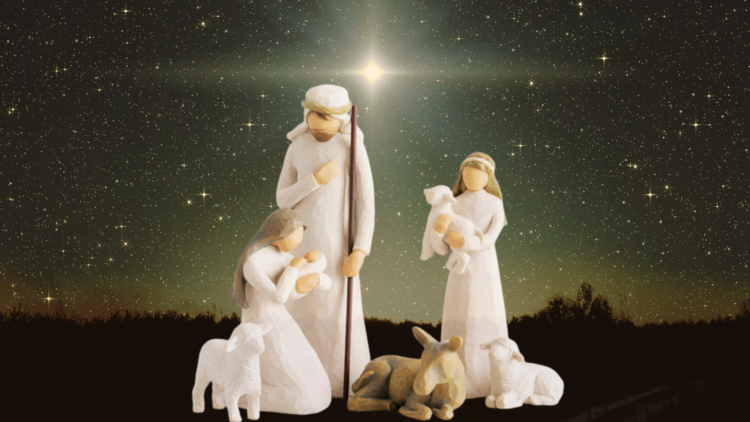“Mommmm! I can’t find Baby Jesus!”
Away in a manger, no crib for his bed, a tiny wooden baby is swaddled in bubble wrap. The figure has no facial features, but his little round head peeks out from under a “cloth” carved from olive wood.
And right now, he is missing.
The day-after-Thanksgiving holiday decorating is sacrosanct in my household. Mariah Carey defrosts her “All I Want for Christmas Is You” classic on the Christmas music TV channel as we decorate our home with holly and pine. Mom sets up the poinsettias and Nutcracker dolls. Dad puts the angel—we are strictly an angel family, not a star family—on top of the tree.
My mom’s handwriting spells out “NATIVITY” on a masking tape label stuck to a red and green paneled box that distinguishes the home of the Nativity scene characters from that of other Christmas trinkets. Despite carefully insulating each of the wooden figures in bubble wrap and sectioning them off in their designated storage bin, each year we lose a figure in the jumble of Christmas decor, or one is broken in some small way when we unwrap it the next December.
Each year we lose a figure in the jumble of Christmas decor, or one is broken in some small way when we unwrap it the next December.
A glob of superglue secures the tiny ear of a lamb. A Scotch tape cast wraps around the limp leg of a donkey. Joseph’s staff was replaced by a small wooden dowel from some childhood craft kit many years ago. Last Christmas, upon unpacking, we lost the small box of myrrh that a wise man once carried. Now he’s just a small wooden figure with his head bowed and hands outstretched as if he’s forgotten the gift for the Prince of Peace on his kitchen counter.
It is not that we don’t care about our crèche. In fact, we hardly consider it just “decor.” It is treated with more reverence and gentleness than the multitude of other generational knickknacks and ancient ornaments that take over our home in December. We lose or break pieces of the Nativity scene because the scene is old and delicate, as many family Christmas decorations are.
While other Christmas decorations come and go throughout our home, our Nativity scene follows a strict tradition. It has its designated spot on a small wooden table in our living room. The iron-wrought star hangs slightly to the left of the scene on a miniature mount. Mary and Joseph take their center mark. One year, my mom wanted to put golden glittery hay around the scene only to have my sisters and I immediately veto her idea and send her back to the craft store with a return receipt in hand.
Our littleness is often made manifest during the holiday season. The Nativity scene is a physical reminder of the moment of incarnation, of Christ sharing in our littleness to save us.
Rebecca, the youngest child, whirls around the house, which is gradually becoming festooned with garlands and lights while an artificially sweet gingerbread candle burns in the kitchen.
“We need the Baby Jesus! That’s the whole point!”
Her declaration catches me off guard as I stuff fake fluffy snow in the corners of our windows. Certainly, the Nativity scene can continue without Joseph’s staff or the myrrh of a wise man. But replacing the Baby Jesus? Now, that would be much more difficult.
The original wooden Jesus interlocks perfectly in the cradle of Mary’s arms, a beautiful representation of a mother and her child. So Rebecca and I troubleshoot some Baby Jesus body doubles that might fit snugly in the arms of the Mary figurine. Right now, the top contender for a replacement is a gold paperclip and two cotton balls taped together. We soon realized that our efforts were better served searching for Jesus rather than trying to replace him.
Pope Francis offered a reflection on the Nativity scene in his apostolic letter, “Admirabile Signum”: “Why does the Christmas crèche arouse such wonder and move us so deeply? First, because it shows God’s tender love: the Creator of the universe lowered himself to take up our littleness”
Our littleness is often made manifest during the holiday season. Amid the rush of gift wrapping and office holiday partying, we forget to honor the true meaning of Christmas: the hopeful coming of the Christ Child. Rebecca was right. We need the Baby Jesus. That’s the whole point.
As we spiritually prepare for the promise of Jesus, we also must search for God’s abounding grace in our lives.
The Nativity scene is a physical reminder of the moment of incarnation, of Christ sharing in our littleness to save us. Advent invites us into a time of searching rather than replacing, to sit with the unsettled anticipation of the coming of Christ. But all too often we pursue a cookie-cutter Christmas experience that reflects the new, store-bought Nativity scene rather than the imperfections and struggle of the biblical accounts. How often do we try to replace Jesus with presents rather than wait for him during the season of Advent?
As we spiritually prepare for the promise of Jesus, we also must search for God’s abounding grace in our lives. Sometimes our human littleness wins out and we manage to ignore or reject that grace, preferring our own opinions to the reality in front of us.
The Nativity scene is a perfect example. My family’s Nativity scene, like so many others that will appear during the holiday season, has some notable inaccuracies. It portrays a fair-skinned holy family, not a Middle Eastern one. There are three magi gathered around the scene, but the only reference to these men in the Bible is in Matthew Chapter Two, where they are not called “wise men” or “kings,” nor is there mention of how many there were. Matthew’s Gospel only describes “some men from the East.” Even the broken but beloved animal figures may have been incorrect, as Pope Benedict XVI wrote that in the accounts of the Gospels, “there is no mention of animals.”
Even though none of these characters in our scene have faces on their small figurine bodies, Mary’s posture makes her look quite settled for a woman who has just given birth after days of travel, and the animals look unbothered by the fact that a literal baby was put in their feeding trough. The figurines look slightly wonky, with their clumsily created imperfections and makeshift bandages. There is simply nothing about our Nativity scene that says “Behold! You are looking at the savior of the world.” (Perhaps my mom was onto something with the golden glittery hay.)
God came to be with us once, and God is still with us. Most of all, we believe that even in our brokenness, God will come among us again.
So why not purchase a new Nativity scene? There are so many different iterations of the scene available for purchase now, including one with lobster figurines or expensive stained glass.
This Nativity scene offers something a new one cannot. It has been uniquely touched by a family of fallible humans and in its very brokenness is a reminder that Christ entered into our littleness. God came to be with us once, and God is still with us. Most of all, we believe that even in our brokenness, God will come among us again.
When I look at my Nativity scene, I see that brokenness, imbued in the human condition, which can emerge even in the moments that seem the holiest. A broken Nativity scene can still be emblematic of the Catholic mission, to persist in the celebration of Christ, even in our imperfections and setbacks—to search for Christ, even when we think he is missing.
As Rebecca and I crawl around and search, a frantic energy of preparation dissipates. Patient searching: an element of Advent that reminds us not to become weary in our waiting but to experience the thrill of hope again. The wooden Baby Jesus is lying still on the corner of our living room carpet, as if he would have been there all along, having tumbled out of the box in a rush of Christmas decorating.
A gasp, then slowly Rebecca opens her palm, revealing the tiny Redeemer who has escaped his bubble wrap swaddling clothes.
Rebecca places him back in the arms of Mother Mary and our Nativity scene, in all its shining imperfections, is complete once more.








